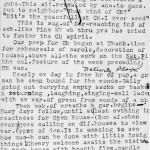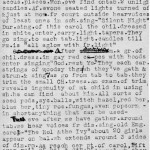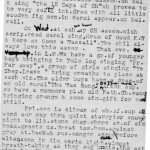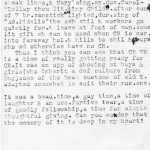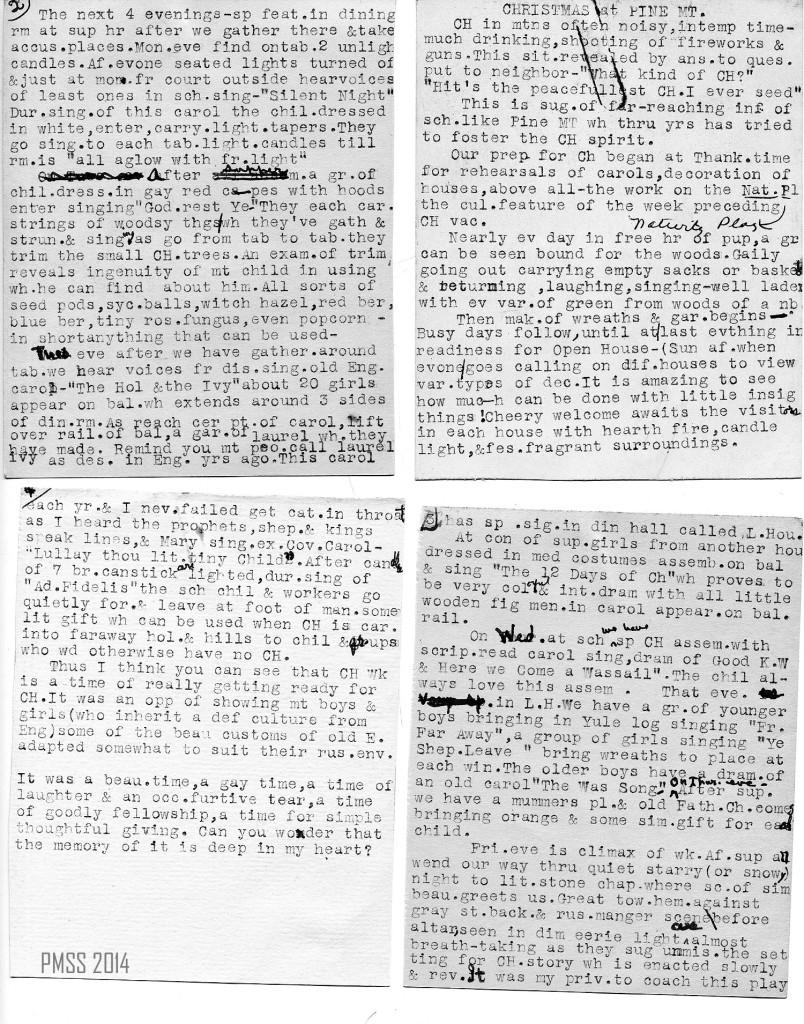Pine Mountain Settlement School
Series 09: BIOGRAPHY – Staff
Series 16: EVENTS
Margaret Motter Talk
Christmas at Pine Mountain
c. 1946-1949
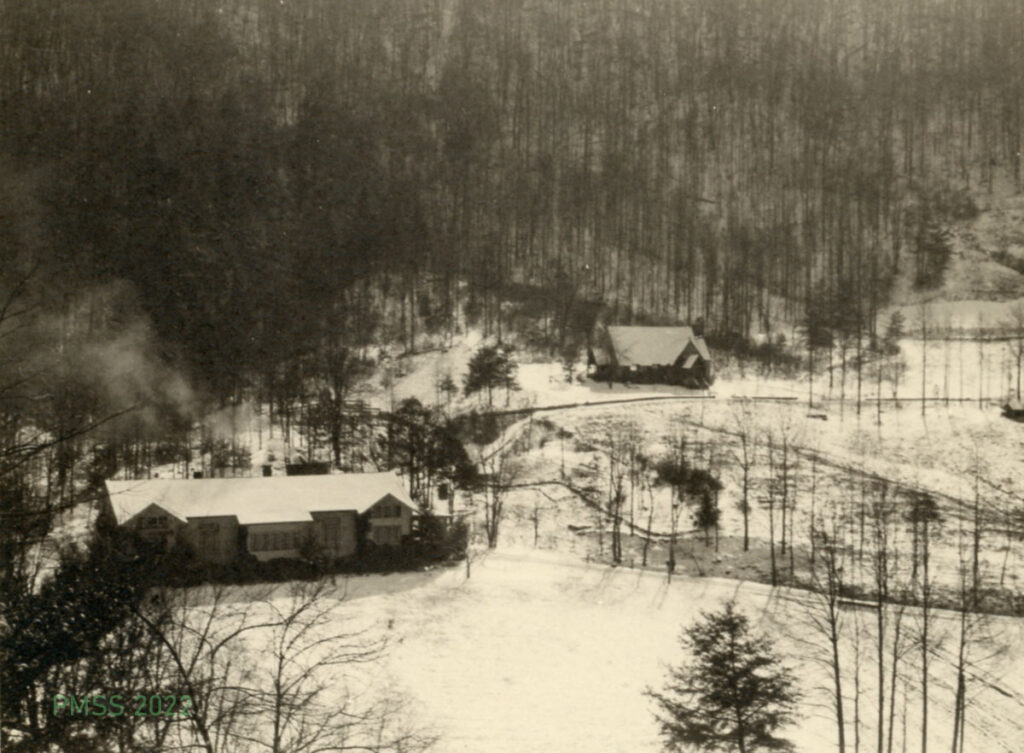
02a Chapel and Laurel House, distant view. [motter_margaret_blk_alb_single_002a]
MARGARET MOTTER TALK Christmas at Pine Mountain
c. 1946-1949
TAGS: Margaret Motter talk, Christmas at Pine Mountain, mountain Christmases, fostering the Christmas spirit, singing of carols, Nativity Play, gathering greenery, making wreaths and laurel garlands, Open House, trimming Christmas trees, medieval costumes, reading of scripture, Laurel House, Yule log, mummers play, Father Christmas, Christmas Week, old English culture
Margaret Motter was a worker at Pine Mountain Settlement School for many years, serving as Principal and Teacher 1928–1938 and Publicity Representative and Head of English Department 1946–1949. She prepared the following speech to present before groups as a fundraiser and publicity representative of the School.
GALLERY: MARGARET MOTTER TALK Christmas at Pine Mountain [pages 1-4]
- pmss_archives_motter_talk_xmas_p1.jpg
- pmss_archives_motter_talk_xmas_p2.jpg
- pmss_archives_motter_talk_xmas_p3.jpg
- pmss_archives_motter_talk_xmas_p4.jpg
TRANSCRIPTION
[NOTE: The text has been slightly altered and abbreviations expanded for readability.]
[page 1] CHRISTMAS at PINE MT.
Christmas in the mountains is often a noisy, intemperate time – much drinking, shooting of fireworks and guns. This situation was revealed by an answer to the question put to a neighbor [about Pine Mountain Christmases] – “What kind of Christmas?” She replied, “Hit’s the peacefullest Christmas I ever seed.”
This is suggestive of far-reaching influence of schools like Pine Mountain which, through the years, has tried to foster the Christmas spirit.
Our preparation for Christmas began at Thanksgiving time for rehearsals of carols, decoration of houses, and above all – the work on the Nativity Play, the cultural feature of the week preceding Christmas vacation.
Nearly every day in the free hour of [pup?], a group can be seen bound for the woods: Gaily going out carrying empty sacks or baskets and returning, laughing, singing – well laden with every variety of green from the woods of a [neighbor?].
Then the making of wreaths and garlands begins. Busy days follow, until at last everything is in readiness for Open House – (Sunday afternoon when everyone goes calling on different houses to view various types of decoration.) It is amazing to see how much can be done with little insignificant things! A cheery welcome awaits the visit in each house with a hearth fire, candlelight, and festive fragrant surroundings.
[page 2] The next four evenings – A special feature occurs in the dining room at supper hour after we gather there and take our accustomed places. Monday evening, we find on our table two unlighted candles. After everyone is seated, the lights are turned off and just at that moment, from the court outside, we hear voices of the least ones in school, singing “Silent Night.” During the singing of this carol the children, dressed in white, enter, carrying light tapers. They go singing to each table and light the candles till the room is “all aglow with [fr.?] light.”
After supper a group of children dress in gay red capes with hoods and enter singing, “God Rest Ye Merry Gentlemen.” They each carry strings of woodsy things, which they’ve gathered and strung and, singing as they go from table to table, they trim the small Christmas trees. An example of trim reveals the ingenuity of the mountain child in using what he can find about him. All sorts of seed pods, sycamore balls, witch hazel, red berries, blue berries, tiny [ros.?] fungus, even popcorn – in short, anything that can be used.
Tuesday evening, after we have gathered around the table, we hear voices from the distance singing the old English carol, “The Holly and the Ivy.” About 20 girls appear on the balcony which extends around three sides of the dining room. As they reach a certain point of the carol, they lit over the railing of the balcony a garland of laurel which they have made. May I remind you that mountain people call laurel, “ivy,” as described in England years ago. This carol…
[page 3]…has a [sp.? sig.?] in the dining hall called [L. Hou.?]
At the conclusion of supper, the girls from another house, dressed in medieval costumes, assemble on the balcony and sing, “The Twelve Days of Christmas,” which proves to be a very colorful and interesting drama when all the little wooden figures mentioned in the carol appear on the balcony rail.
On Wednesday at the School we have a special Christmas assembly with scripture read, carols sung, a drama of “Good King Wenceslas” and “Here We Come a-Wassailing.” The children always love this assembly.
That evening in Laurel House, we have a group of younger boys bringing in the Yule log, singing “From Far Away,” and a group of girls singing “Ye Shepherds Leave…,” bringing wreaths to place at each window. The older boys have a drama of an old carol, “There was a Song.”
On Thursday evening after supper we have a mummers play and old Father Christmas comes bringing oranges and some simple gift for each child.
Friday evening is the climax of the week. After supper all wend our way through the quiet starry (or snowy) night to the little stone chapel where a scene of simple beauty greets us: A great towering hemlock against a gray [st.?] background and a rustic manger scene before the altar, seen in dim eerie light. It is almost breathtaking as they suggest unmistakably the setting for the Christmas story which is enacted slowly and reverently. It was my privilege to coach this play…
[page 4]…each year and I never failed to get a catch in my throat as I heard the prophets, shepherds, and kings speak lines, and Mary sing [ex.?] the Coventry Carol – “Lullay thou little tiny Child.” After the candles of seven [br.?] candlesticks are lighted during the singing of “Adeste Fideles,” the school children and workers go quietly forward and leave at the foot of the manger some little gift which can be used when Christmas is carried into the faraway hollers and hills to children and grownups who would otherwise have no Christmas.
Thus I think you can see that Christmas Week is a time of really getting ready for Christmas. It was an opportunity of showing mountain boys and girls (who inherit a definite culture from England) some of the beautiful customs of old England, adapted somewhat to suit their rustic environment.
It was a beautiful time, a gay time, a time of laughter and an occasional furtive tear, a time of goodly fellowship, a time for simple thoughtful giving. Can you wonder that the memory of it is deep in my heart?
Click HERE for a BIOGRAPHY OF MARGARET MOTTER
Return to GUIDE TO THE MARGARET MOTTER COLLECTION
Return to GUIDE TO CHRISTMAS AT PMSS

